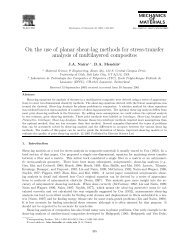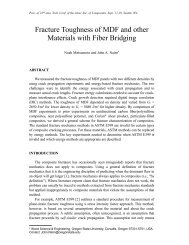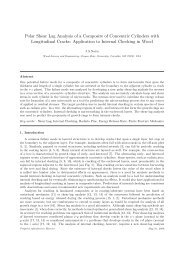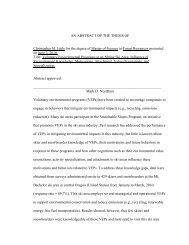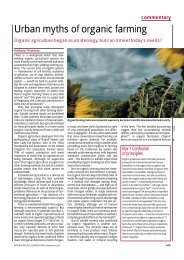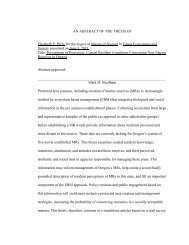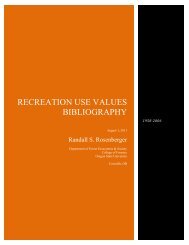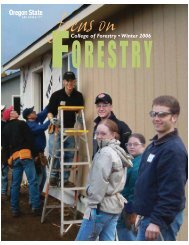College of Forestry - Oregon State University
College of Forestry - Oregon State University
College of Forestry - Oregon State University
You also want an ePaper? Increase the reach of your titles
YUMPU automatically turns print PDFs into web optimized ePapers that Google loves.
Features<br />
H. J. Andrews Experimental Forest: Learning in the Present,<br />
Building on the Past, Looking to the Future<br />
[The Andrews]… is the most studied primal forest ecosystem on this continent, and perhaps the planet. …Here,<br />
in the shadows <strong>of</strong> this woods, in its rivulets and streams, under its soil, and high overhead, they have discovered<br />
a hidden forest.—Jon Luoma, The Hidden Forest<br />
Tucked away in the Cascade Mountains near<br />
Blue River, the HJ Andrews Experimental<br />
Forest has been yielding its secrets to scientists<br />
for nearly 60 years. “The Andrews”,<br />
as it is known to its many friends, was<br />
founded in 1948. In 1980, it became a charter member <strong>of</strong><br />
the National Science Foundation Long-Term Ecological<br />
Research Program,<br />
which now comprises<br />
26 sites. Over the<br />
decades, scientists<br />
from all over the<br />
world have found<br />
their way to the narrow<br />
mountain road<br />
leading to the Forest<br />
and its 16,000 acres <strong>of</strong><br />
forests and streams.<br />
Its reputation for excellence in research and education in<br />
the ecology and management <strong>of</strong> forests and streams has<br />
grown and spread accordingly.<br />
Dominant research themes have changed over time.<br />
In the 1950s and 1960s, the focus was on road engineering,<br />
logging methods for old-growth forests, rapid forest<br />
regeneration, and effects <strong>of</strong> logging on small watersheds.<br />
Current researchers, building on long-term field experiments<br />
and measurements, are developing concepts and<br />
tools to predict effects <strong>of</strong> natural disturbance, land use,<br />
and climate change on ecosystem structure, function,<br />
and species composition. Applied forest management<br />
studies continue today as part <strong>of</strong> a long-term partnership<br />
with the Willamette National Forest.<br />
“We have a wealth <strong>of</strong> long-term datasets on Pacific<br />
Northwest forests and streams, which is important for<br />
such long-lived forests,” notes Kari O’Connell, Director<br />
<strong>of</strong> the Forest.“ These datasets can be used in novel<br />
and unpredicted ways over the years.” Permanent study<br />
areas make it possible to examine natural and management-induced<br />
changes over time and to examine effects<br />
21<br />
<strong>of</strong> catastrophic events. A 200-year experiment on log<br />
decomposition is helping scientists understand the roles <strong>of</strong><br />
logs on the forest floor as habitat and in soil productivity.<br />
Climate variation is being tracked over decades. Watershed<br />
hydrological research is building on treatments established<br />
50 years ago, and the same watersheds are now being used<br />
as “airsheds” to develop new techniques <strong>of</strong> studying carbon<br />
dynamics in mountainous areas. The many long-term<br />
databases are updated continually. They are available online<br />
to researchers and students from all over the world to<br />
compare with other ecosystems, use as learning tools, and<br />
assess environmental and ecological changes.<br />
Although basic and applied forest science is central<br />
to the mission <strong>of</strong> the Andrews, students and teachers<br />
from elementary school to graduate school all have found<br />
something to learn there. From time to time, too, creative<br />
writers and philosophers join ecosystem scientists at the<br />
Andrews and other natural places as participants in the<br />
Long-Term Ecological Reflections program to explore<br />
human/nature relationships.<br />
The Andrews is administered cooperatively by <strong>Oregon</strong><br />
<strong>State</strong> <strong>University</strong> and the USDA Forest Service’s Willamette<br />
National Forest and Pacific Northwest Research<br />
Station. The research and educational programs are also<br />
funded by the National Science<br />
Foundation, NASA, the USGS,<br />
and diverse other sources.<br />
“One aspect <strong>of</strong> the Andrews<br />
has stayed the same over the<br />
decades,” O’Connell observes.<br />
“Studies here continue to provide<br />
critical information about forest<br />
and stream ecology and management<br />
to scientists, policymakers,<br />
and everyone else concerned<br />
with sustaining <strong>Oregon</strong>’s forests.”<br />
More information about the<br />
Andrews is available at www.fsl.<br />
orst.edu/lter/.





